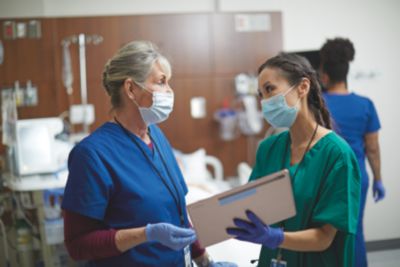
Interoperability technology partnerships
- By Philips
- October 31 2025
- 3 min read
Clinicians shouldn’t have to work around disconnected systems to deliver great care. Often, fragmented technologies stand in the way of efficiency and insight. We’re committed to building an open ecosystem and to creating partnerships so our devices can communicate, no matter who makes them. At Philips it's not enough that our devices connect to one another, we want all devices to connect to help clinicians deliver efficient care. By breaking down these barriers, we envision a truly connected environment where data flows freely across systems, giving clinicians unified insight and control.
At-a-glance:
- Philips partners with other technology companies that are also committed to interoperability and SDC standards to create a connected hospital environment.
- We’ve formed technology partnerships with leading critical care companies.
- These partnerships will give clinicians a way to see and act upon data derived from medical devices all through a Philips monitoring platform.
- This can simplify ICU workflows, help centralize alarm management and potentially reduce the complexity of the hospital environment.

Like Philips, our interoperability-focused technology partners embrace Service-oriented Device Connectivity (SDC) standards, which will allow new levels of interoperability across medical devices and platforms. To help our customers truly benefit from using SDC-enabled devices, we’ve partnered with other companies through the SDC consortium to help us develop and test the SDC standards. We also partner with companies on a one-on-one basis to find ways to bring together data from their devices and stream it through the Philips monitoring ecosystem.
Partnerships to unlock advanced workflows
The adoption of SDC standards allows the integration of diverse data streams, including vital signs, waveforms and alarm information, into a unified, centralized system. This interoperability supports centralized alarm management, allowing clinicians to monitor and respond to patient needs from a single interface. In addition to creating more efficient workflows for clinicians, SDC alarm management can also create a tranquil hospital experience for patients.
We are currently collaborating with five leading critical care companies to integrate data streams and advance SDC alarm management in intensive care.
- We work with Dräger and Hamilton Medical to facilitate communication between their ventilators and our monitors.
- We partner with Getinge and Lowenstein to connect their ventilators and anesthesia machines to our patient monitoring ecosystem.
- We partner with leading infusion pump company B.Braun to use the SDC standard for integration to drive both of our products into a powerful joint solution for customers.
Interoperability partnerships beyond SDC
Interoperability is also at the heart of many of our non SDC-focused technology partnerships. We collaborate with wearable biosensor companies to close gaps in vital signs monitoring and open new sightlines into patients’ status in the hospital and at home. We partner with other patient monitoring companies to integrate their measurement technologies into Philips patient monitors, allowing clinicians to use their preferred technologies within a single, integrated system.
Our mobile workflow-focused partnerships go beyond bringing together integrated clinical measurements from across devices by also allowing caregivers to act on those insights remotely. Finally, we partner with companies that share our vision for an open operating room (OR) – where interoperable monitoring unlocks a complete patient view by integrating relevant diagnostic parameters into the Philips hospital patient monitoring infrastructure.
The goal of all of Philips technology partnerships is to create a smarter, more responsive care setting – one that empowers clinical teams, reduces complexity and supports better experiences for caregivers, IT teams and patients alike.
Copy this URLto share this story with your professional network
Disclaimer
Results are specific to the institution where they were obtained and may not reflect the results achievable at other institutions. Results in other cases may vary.